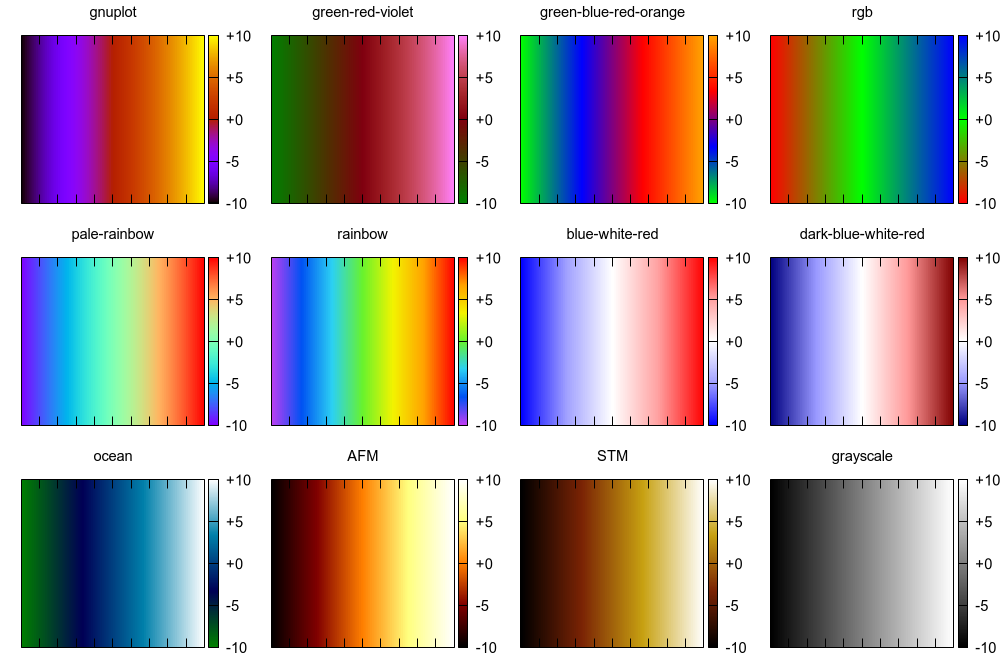TABLE OF CONTENTS
::pwtk::splot
SYNOPSIS
proc ::pwtk::splot {args} {
USAGE
splot ?OPTIONS? DATAFN
where DATAFN is either a datafile or a function to plot, and
OPTIONS are:
-type TYPE
-pal PALETTE
-i INTERPOLATION
-contour
-cc CONTOUR_COLOR
-clw CONTOUR_LINEWIDTH
-xl XLABEL
-yl YLABEL
-zl ZLABEL
-xr XRANGE
-yr YRANGE
-zr ZRANGE
-cbr CBRANGE
-xf XFORMAT
-yf YFORMAT
-zf ZFORMAT
-cbf CBFORMAT
-u USING
-w WITH
-e EXTRA
-t TERMINAL
-v
OPTIONS
Options specific for 3D surface plots:
- -type TYPE --- type of the Gnuplot splot: surface | both (default = surface; "TYPE = both" means surface + map)
- -pal PALETTE --- color palette for the splot (PWTK has a dozen predefined palettes, see the image below)
- -i NX,NY --- interpolation degree along X- and Y-axis (default is set to auto-optimal interpolation)
- -contour --- plot contours
- -cc CONTOUR_COLOR --- assigns contour color
- -clw CONTOUR_LINEWIDTH --- contour linewidth
General options:
- -xl XLABEL --- X-axis label
- -yl YLABEL --- Y-axis label
- -zl ZLABEL --- Z-axis label
- -xr XRANGE --- X-axis range specified as XMIN:XMAX or {XMIN:XMAX} or "XMIN:XMAX"
- -yr YRANGE --- Y-axis range specified as YMIN:YMAX or {YMIN:YMAX} or "YMIN:YMAX"
- -zr ZRANGE --- Z-axis range specified as ZMIN:ZMAX or {ZMIN:ZMAX} or "ZMIN:ZMAX"
- -cbr CBRANGE --- CB-axis range specified as CBMIN:CBMAX or {CBMIN:CBMAX} or "CBMIN:CBMAX"
- -xf XFORMAT --- format for X-axis (e.g. %.2f)
- -yf YFORMAT --- format for Y-axis (e.g. %.2f)
- -zf ZFORMAT --- format for Z-axis (e.g. %.2f)
- -cbf CBFORMAT --- format for CB-axis (e.g. %.2f)
- -u USING --- Gnuplot's "using" splot specification
- -w WITH --- Gnuplot's "with" splot specification
- -e EXTRA --- extra Gnuplot commands/configuration, e.g., -e {set nokey; set title 'simple plot'}
- -t TERMINAL --- terminal for the plot
- -v --- visualize the generated image(s) (for file terminals)
ARGUMENT
- datafile --- datafile to plot
PURPOSE
A fast way of making an splot from the x, y, f(x,y) tabulated data. For a more elaborate 3D plotting, use the ::pwtk::gp::splot object-oriented interface instead.
The PWTK's predefined color palettes can be accessed with the -pal option. To invert a palette, use "-pal {PALETTE negative}", where PALETTE is one of:

Note that for PALETTE only a substring that uniquely identifies it is required. For example, "-pal pa" selects the "pale-rainbow" palette.
RETURN VALUE
- the name of created image (for file terminals)
- an empty string (for non-file terminals)
SOURCE
variable write_fid variable plot_id # parse args set narg 1 ::pwtk::splotParseOpt_ # datafile or function ? if { [file exists $args] } { # lastarg is a file finish $args set head splot-[file rootname $args] set datafn [squote $args] } else { # lastarg is a function set id [incr ::pwtk::gp::splot_id] set head splot-$id set datafn $args } # options post-processing set opts "" ifnotempty opt(pal) { append opts "[list -pal $opt(pal)] " } ifnotempty opt(cc) { append opts "[list -cc $opt(cc)] " } if { ! $opt(contour) } { append opts "-nocontour " } ifnotempty opt(clw) { set opt(clw) "lw $opt(clw)" } ifnotempty opt(u) { set opt(u) "u $opt(u)" } ifset opt(w) l set with [concat w $opt(w) $opt(clw)] # create Gnuplot splot object set gp [::pwtk::gp::splot new -type $opt(type) {*}$opts $head.$opt(t)] # add options + add excerpts ::pwtk::splotOptionsAdd_ # plot $gp plot [concat $datafn $opt(u) $with] $gp exec set output [$gp outputs] $gp destroy displayPlots_ $opt(v) $opt(t) $output return $output }